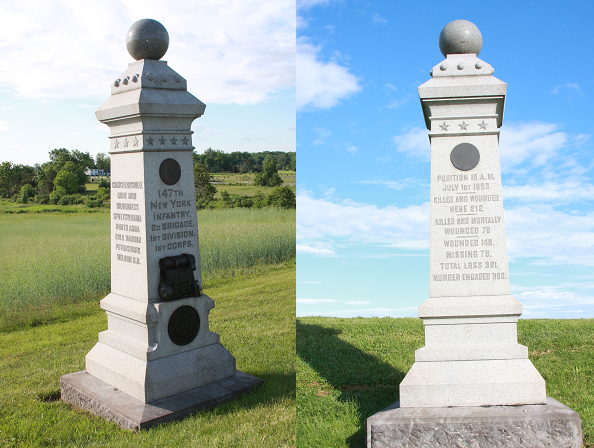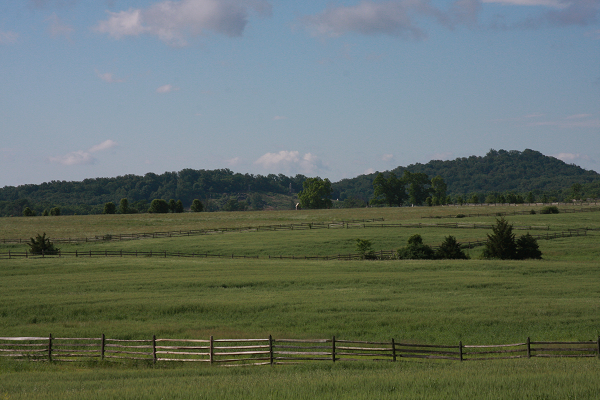May 27-28, 2022
Site Visit #28
Gettysburg National Military Park was my third Civil War battlefield in my last four park visits. Of course, it makes sense that I would hit these three as they all lie within a 20-mile radius. I ended up spending parts of two days at Gettysburg. The first day was marred a bit by a torrential downpour in the early afternoon.
I’m not going to rehash the actual battle. See the movie “Gettysburg” if you want a very accurate portrayal of the battle. Unlike Antietam and Monocacy, each of which lasted just one day, this battle lasted for three grueling days in early July, 1863, with temperatures a baking 90°F+ on all three days. Like Antietam, casualties were appalling. At the end of the three days, 51,000 men had been killed, wounded, or captured.
Gettysburg was a battle not intended to be fought. General Robert E. Lee again invaded a northern state hoping to force a major battle and win, breaking any confidence the population had on a Union victory. His army was already spread across south-central Pennsylvania, stealing food and supplies from local citizens. General George Meade had just been appointed commander of the Army of the Potomac, the Union forces that had been fighting in Virginia, and immediately headed his army into Pennsylvania in pursuit.
Union Cavalry General John Buford was scouting the lands near Gettysburg when he spotted one of the Confederate armies moving toward the city from the northwest. He had not expected to see southern forces in this area and got word back to General Meade and to I Corps commander General John Reynolds. The Confederate General, Henry Heth was even more stunned to see Union troops in Gettysburg as General Lee did not think any were this close. Lee had ordered all of his armies to converge upon Gettysburg, not with the intent of fighting there, but to move forward, find the main Union army, and crush them. Heth held back his troops awaiting instructions.
Buford ordered his small cavalry unit to set up defenses to slow the approaching Confederates. He was hoping Reynold’s I Corps would arrive early the next morning to provide more support. Reynolds did indeed arrive and his troops immediately went into battle against Heth’s now attacking forces.
One regiment of Reynolds Corps was the 147th New York infantry, and within that regiment was Cpl Cyrus E. Brown, my great, great, (great?) uncle. His regiment was one of the first (after Buford’s cavalry) to engage in the battle.

Total Loss 301
Number engaged 390;
The monument to the 147th New York shows the unit’s casualties in the battle: 380 men engaged, 301 killed, wounded, or missing. Uncle Cy was one of the wounded, though he recovered enough to fight 10 months later at the Wilderness, where he was seriously wounded and left for dead on the battlefield. He crawled to safety and lived into the 1920s.
Gettysburg Military Park is a bit unusual in the Park System. There is no charge to enter the park, follow the auto tour of the battlefield, or wander around the Visitor’s Center. However, the film shown in the Visitor’s Center costs almost $18.00, though that also includes viewing the Cyclorama program immediately after the film. This charge (for which my Senior Park Pass was of no value) is because the film and Cyclorama are run by the Gettysburg Foundation, not the Park Service. The film was good, but so are many of the free films in other parks. The Cyclorama was impressive – a painting that wraps around the entire room, some 42 feet high and 311 feet “wide”. It depicts Pickett’s Charge. A multimedia presentation of the charge makes use of lighting against the painting along with sound effects and narration. It is nicely done and worth seeing once.
As eluded to above, there is an auto tour of the battlefield that can play on one’s cell phone. Each stop has textual information along with an audio description by a park ranger of what was happening at that location.
One thing I found interesting was the term “ridge”. Much of the battle on days 2 and 3 took place between Seminary Ridge (held by the Confederates) and Cemetery Ridge (held by the Union). When I hear the word “ridge”, I think back to my backpacking trips in the Appalachian Mountains. A ridge was merely a straight mountain whose top might run for 10-20 miles. But that ridge line was still some 300-500 feet above the valley below.

The “ridges” at Gettysburg are more like bumps in the topography. They look like waves; long runs of slight elevation increases. In a few cases, like the Round Tops, there are good views from the top. From others, like some points on Seminary Ridge, you are only a dozen or so feet above the rest of the land.
Yesterday, my first at Gettysburg, I spent my morning in the Visitor’s Center, watching the movie, checking out the museum, and attending a ranger presentation of an overview of the battle. After lunch, I decided to head out on the auto tour as the predicted rains had held off. As I approached stop number 1, the rains started. By the time I was to the third stop, it was a torrential downpour. The audio of the tour would say “…notice the hills in the distance where…” and I not only didn’t “notice” those distant hills, I could barely see across the road!
Today’s weather promised to be better. Since the park opens at sunrise, I decided I would head back and try to get some photos of the spots I didn’t see very well yesterday. I also stopped by the Eisenhower National Historic Site during the early morning hours (more on that in a separate blog). The weather was perfect, with lots of sunshine and temps in the upper 60s. I passed through an empty Visitor’s Center parking lot on my way to getting a photo of me next to the park sign. A few hours later as I headed out, the parking lot was overflowing. The area was packed with people. It was a Saturday in late May and Memorial Day weekend. I made a good decision to come yesterday to the Visitor’s Center and early today for the tour.
My final stop was the National Cemetery. Around 7,800 men were killed during the three-day battle. Many of the Union dead were eventually buried in the new National Cemetery, which was dedicated on November 19, 1863. Edward Everett, at that time, one of the nation’s greatest orators, gave a two-hour speech dedicating the cemetery. Once finished, almost as a mere courtesy, the President of the United States was asked to deliver a few words. Abraham Lincoln spoke for just two minutes, pointing out that “the world will little note nor long remember what we say here”. Almost 160 years later, his two minutes are still remembered as one of the greatest speeches in American history.
Steve